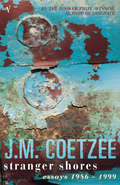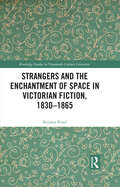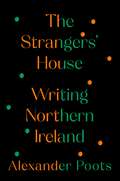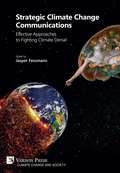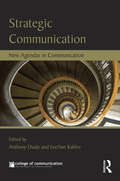- Table View
- List View
Stranger Shores: Literary Essays
by J. M. CoetzeeJ. M. Coetzee is, without question, one of the world's greatest novelists. This volume gathers together for the first time in book form twenty-nine pieces on books, writing, photography and the 1995 Rugby World Cup in South Africa. Stranger Shores opens with 'What is a Classic?' in which Coetzee explores the answer to his own question - 'What does it mean in living terms to say that the classic is what survives?' - by way of T.S. Eliot, J.S. Bach and Zbigniew Herbert. His subjects range from eighteenth and nineteenth century writers Daniel Defoe, Samuel Richardson and Ivan Turgenev, to the great German modernists Rilke, Kafka, and Musil, to the giants of late twentieth century literature, among them Harry Mulisch, Joseph Brodsky, Jorge Luis Borges, Salman Rushdie, Amos Oz, Naguib Mahfouz, Nadine Gordimer and Doris Lessing.
Strangers and the Enchantment of Space in Victorian Fiction, 1830–1865 (Routledge Studies in Nineteenth Century Literature)
by Kristen PondTracing the origins of how we think about strangers to the Victorian period, Strangers and the Enchantment of Space in Victorian Fiction, 1830-1865 explores the vital role strangers had in shaping social relations during the cultural transformations of the industrial revolution, transportation technologies, and globalization. While studies of nineteenth-century Britain tend to trace the rise of an aloof cosmopolitanism and distancing narrative strategies, this volume calls attention to the personalizing impulse in nineteenth-century literary form, investigating the deeply personal reflections on individual and national identities. In her book, Dr. Pond leads the reader through homes of the urban poor, wandering the Great Exhibition in the Crystal Palace, loitering in suburban neighborhoods, riding the railway, and touring a country estate. Readers will experience how the ordinary can be enchanting, and how the mundane can be unexpected, discovering a new way of thinking about strangers and their influence on our lives. Through an examination of the short and long fictional forms of Martineau, Dickens, Brontë, Gaskell, and Braddon, this study locates the figure of the stranger as a powerful topos in the story Victorian literature and the ethics of social relations. This book will be ideal for those seeking to understand the dynamics of the stranger in Victorian fiction as a figure for understanding the changing dynamics of social relations in England in the early nineteenth century.
Strangers and the Enchantment of Space in Victorian Fiction, 1830–1865 (Routledge Studies in Nineteenth Century Literature)
by Kristen PondTracing the origins of how we think about strangers to the Victorian period, Strangers and the Enchantment of Space in Victorian Fiction, 1830-1865 explores the vital role strangers had in shaping social relations during the cultural transformations of the industrial revolution, transportation technologies, and globalization. While studies of nineteenth-century Britain tend to trace the rise of an aloof cosmopolitanism and distancing narrative strategies, this volume calls attention to the personalizing impulse in nineteenth-century literary form, investigating the deeply personal reflections on individual and national identities. In her book, Dr. Pond leads the reader through homes of the urban poor, wandering the Great Exhibition in the Crystal Palace, loitering in suburban neighborhoods, riding the railway, and touring a country estate. Readers will experience how the ordinary can be enchanting, and how the mundane can be unexpected, discovering a new way of thinking about strangers and their influence on our lives. Through an examination of the short and long fictional forms of Martineau, Dickens, Brontë, Gaskell, and Braddon, this study locates the figure of the stranger as a powerful topos in the story Victorian literature and the ethics of social relations. This book will be ideal for those seeking to understand the dynamics of the stranger in Victorian fiction as a figure for understanding the changing dynamics of social relations in England in the early nineteenth century.
The Strangers' House: Writing Northern Ireland
by Alexander PootsA penetrating study and celebration of Northern Irish literature—telling the region&’s story through the extraordinary novels and poetry produced by decades of conflict. Northern Ireland is one hundred years old. Northern Ireland does not exist. Both of these statements are true. It just depends who you ask. How do you write about a place like this? THE STRANGERS' HOUSE asks this question of the region&’s greatest writers, living and dead. What have they made of Northern Ireland – and what has Northern Ireland made of them? Northern Ireland is roughly the same size as the State of Connecticut, yet has produced an extraordinary number of celebrated poets and novelists. Louis MacNeice, too clever to be happy, formed by his childhood on the shores of Belfast Lough; son of a Protestant clergyman &“banned for ever from the candles of the Irish poor&”. C. S. Lewis, who discovered Narnia in the rolling drumlins and black rock of County Down. Anna Burns, chronicler of North Belfast and winner of the Booker Prize. And Seamus Heaney, the man of wry precision, the poet with the gift of surprise. As well as household names, Poots also examines writers who may be less familiar to an American readership. These include the dark and bawdy novels of Ian Cochrane, a half-blind writer obsessed with Columbo, and Forrest Reid, a man who saw Arcadia in the Irish countryside, and who was, perhaps, the North&’s first queer author. Reading the work of these writers together produces a testament to over one hundred years of literary endeavor and human struggle. THE STRANGERS' HOUSE is the story of how men and women have written about a home divided, and used their work to move, in the words of Seamus Heaney, &“like a double agent among the big concepts.&”
Strangers in Berlin: Modern Jewish Literature between East and West, 1919–1933 (Michigan Studies In Comparative Jewish Cultures)
by Rachel SeeligBerlin in the 1920s was a cosmopolitan hub where for a brief, vibrant moment German-Jewish writers crossed paths with Hebrew and Yiddish migrant writers. Working against the prevailing tendency to view German and East European Jewish cultures as separate fields of study, Strangers in Berlin is the first book to present Jewish literature in the Weimar Republic as the product of the dynamic encounter between East and West. Whether they were native to Germany or sojourners from abroad, Jewish writers responded to their exclusion from rising nationalist movements by cultivating their own images of homeland in verse, and they did so in three languages: German, Hebrew, and Yiddish. Author Rachel Seelig portrays Berlin during the Weimar Republic as a “threshold” between exile and homeland in which national and artistic commitments were reexamined, reclaimed, and rebuilt. In the pulsating yet precarious capital of Germany’s first fledgling democracy, the collision of East and West engendered a broad spectrum of poetic styles and Jewish national identities.
Strategic Climate Change Communications: Effective Approaches to Fighting Climate Denial (PDF) (Series on Climate Change and Society)
by Jasper FessmannFor over 30 years the science on climate change has been clear: it is happening, we humans caused it, and it puts all our futures at risk. Global warming can still be reversed, or at least the worst prevented, if we act in time. However, despite valiant efforts by scientists, activists and science reporters, little meaningful change has occurred. This is largely the result of well-funded professional strategic communication efforts by vested interests. They have been highly successful in achieving their central goal: protecting the profitable status quo by creating gridlock to slow down meaningful action on climate change. Strategic Climate Science Communications: Effective Approaches to Fighting Climate Denial analyzes some of the communication strategies employed by deniers and the psychological mechanisms behind how they work. Several experts offer specific counter-strategies to change the conversation and foster meaningful societal change on global warming. The book helps environmental journalists to build up resistance against being manipulated by highly effective public relations techniques often successfully used against them. It can also help scientists and activists to become more effective communicators. An effective strategy is best countered by even better strategy.
Strategic Communication: New Agendas in Communication (New Agendas in Communication Series)
by Anthony Dudo LeeAnn KahlorThe focus of this book is Strategic Communication. Communication can be defined as strategic if its development and/or dissemination is driven by an expected outcome. These outcomes can be attitudinal, behavioral, persuasive or knowledge-related; they can lead to change or engagement, or they can miss their mark entirely. In looking at strategic communication, one is not limited to a specific context or discipline. Many of the scholars in the volume are generating research that covers strategic communication in ways that are meaningful across fields. This volume collects the work and idea of scholars who cover the spectrum of strategic communication from source to message to audience to channel to effects. Strategic Communication offers news perspectives across contexts and is rooted firmly in the rich research traditions of persuasion and media effects. Spanning multiple disciplines and written to appeal to a large audience, this book will be found in the hands of researchers, graduate students, and students doing interdisciplinary coursework.
Strategic Communication: New Agendas in Communication (New Agendas in Communication Series)
by Anthony Dudo LeeAnn KahlorThe focus of this book is Strategic Communication. Communication can be defined as strategic if its development and/or dissemination is driven by an expected outcome. These outcomes can be attitudinal, behavioral, persuasive or knowledge-related; they can lead to change or engagement, or they can miss their mark entirely. In looking at strategic communication, one is not limited to a specific context or discipline. Many of the scholars in the volume are generating research that covers strategic communication in ways that are meaningful across fields. This volume collects the work and idea of scholars who cover the spectrum of strategic communication from source to message to audience to channel to effects. Strategic Communication offers news perspectives across contexts and is rooted firmly in the rich research traditions of persuasion and media effects. Spanning multiple disciplines and written to appeal to a large audience, this book will be found in the hands of researchers, graduate students, and students doing interdisciplinary coursework.
Strategic Communication and AI: Public Relations with Intelligent User Interfaces (Routledge Insights in Public Relations Research)
by Simon Moore Roland HübscherThis concise text provides an accessible introduction to Artificial Intelligence and Intelligent User Interfaces (IUIs) and how they are at the heart of a communication revolution for strategic communications and public relations. Intelligent user interfaces are where users and technology meet - via computers, phones, robots, public displays etc. They use AI and machine learning methods to control how those systems interact, exchange data, learn from and develop relations with users. The authors explore research and developments that are already changing human/machine engagement in a wide range of areas from consumer goods, healthcare and entertainment to community relations, crisis management and activism. They also explore the implications for public relations of how technologies developing hyper-personalized persuasion could be used to make choices for us, navigating the controversial space between influence, nudging, and controlling. This readable overview of the applications and implications of AI and IUIs will be welcomed by researchers, students and practitioners in all areas of strategic communication, public relations and communications studies.
Strategic Communication and AI: Public Relations with Intelligent User Interfaces (Routledge Insights in Public Relations Research)
by Simon Moore Roland HübscherThis concise text provides an accessible introduction to Artificial Intelligence and Intelligent User Interfaces (IUIs) and how they are at the heart of a communication revolution for strategic communications and public relations. Intelligent user interfaces are where users and technology meet - via computers, phones, robots, public displays etc. They use AI and machine learning methods to control how those systems interact, exchange data, learn from and develop relations with users. The authors explore research and developments that are already changing human/machine engagement in a wide range of areas from consumer goods, healthcare and entertainment to community relations, crisis management and activism. They also explore the implications for public relations of how technologies developing hyper-personalized persuasion could be used to make choices for us, navigating the controversial space between influence, nudging, and controlling. This readable overview of the applications and implications of AI and IUIs will be welcomed by researchers, students and practitioners in all areas of strategic communication, public relations and communications studies.
Strategic Communication and Deformative Transparency: Persuasion in Politics, Propaganda, and Public Health (Routledge Focus on Communication Studies)
by Isaac Nahon-SerfatyThis book examines deformative transparency and its different manifestations in political communication, propaganda and public health. The objective is to present the theoretical foundations of deformative transparency, as grotesque and esperpentic transparency, and illustrate the validity of such approach to understand the strategic and ethical implications of the proactive disclosure of the "shocking", "ugly" or "outside the norm". Four areas are discussed: political communication with particular focus on populist politicians as the deceased Venezuelan president Hugo Chávez, the campaign and presidency of Donald Trump, and the tenure in office of the mayor of Toronto, Rob Ford; propaganda strategies of Islamist terrorist organizations such as the Islamic State’s escalation of the visually horrific; and public health campaigns that use "disturbing images" to promote public awareness and eventually influence behavioural change. This study on the transparently grotesque is part of a research program about the economy of emotions in public communication.
Strategic Communication and Deformative Transparency: Persuasion in Politics, Propaganda, and Public Health (Routledge Focus on Communication Studies)
by Isaac Nahon-SerfatyThis book examines deformative transparency and its different manifestations in political communication, propaganda and public health. The objective is to present the theoretical foundations of deformative transparency, as grotesque and esperpentic transparency, and illustrate the validity of such approach to understand the strategic and ethical implications of the proactive disclosure of the "shocking", "ugly" or "outside the norm". Four areas are discussed: political communication with particular focus on populist politicians as the deceased Venezuelan president Hugo Chávez, the campaign and presidency of Donald Trump, and the tenure in office of the mayor of Toronto, Rob Ford; propaganda strategies of Islamist terrorist organizations such as the Islamic State’s escalation of the visually horrific; and public health campaigns that use "disturbing images" to promote public awareness and eventually influence behavioural change. This study on the transparently grotesque is part of a research program about the economy of emotions in public communication.
Strategic Communication and its Role in Conflict News: A Computational Analysis of the International News Coverage on Four Conflicts
by Marc JungblutMarc Jungblut extends existing knowledge on the role of strategic communication in conflict news by examining four violent conflicts. He relies on an automated content analysis of texts by 52 strategic communicators, such as politicians, NGOs, social movements, as well as on the international news coverage in 17 media outlets. By analyzing over 80,000 texts in seven languages, the book demonstrates that media visibility is almost exclusively granted based on ethnocentrism and elite status. The journalistic framing of conflict events, however, is much more context-dependent and shows a higher degree of independence from elite voices and strategic communication in general.
Strategic Communication, Corporatism, and Eternal Crisis: The Creel Century (Routledge Focus on Public Relations)
by Phil GrahamThis book traces a century of militarised communication that began in the United States in April, 1917, with the institution of the Committee on Public Information (CPI), headed by George Creel and tasked with persuading a divided US public to enter World War I. Creel achieved an historic feat of communication: a nationalising mass mediation event well before any instantaneous mass media technologies were available. The CPI’s techniques and strategies have underpinned marketing, public relations, and public diplomacy practices ever since. The book argues that the CPI’s influence extends unbroken into the present day, as it provided the communicative and attitudinal bases for a new form of political economy, a form of corporatism, that would come to its fullest flower in the “globalisation” project of the mid-1990s.
Strategic Communication, Corporatism, and Eternal Crisis: The Creel Century (Routledge Focus on Public Relations)
by Phil GrahamThis book traces a century of militarised communication that began in the United States in April, 1917, with the institution of the Committee on Public Information (CPI), headed by George Creel and tasked with persuading a divided US public to enter World War I. Creel achieved an historic feat of communication: a nationalising mass mediation event well before any instantaneous mass media technologies were available. The CPI’s techniques and strategies have underpinned marketing, public relations, and public diplomacy practices ever since. The book argues that the CPI’s influence extends unbroken into the present day, as it provided the communicative and attitudinal bases for a new form of political economy, a form of corporatism, that would come to its fullest flower in the “globalisation” project of the mid-1990s.
Strategic Communication for Startups and Entrepreneurs in China (Routledge Insights in Public Relations Research)
by Linjuan Rita Men Yi Grace Ji Zifei Fay ChenThis book presents a comprehensive guide for public relations and strategic communication professionals and entrepreneurs to effectively manage the communication aspects of startups in the context of business in China. Drawing on interdisciplinary theories, current issues, and updated research evidence obtained from entrepreneurs and startup leaders in China, this concise volume provides research-based insights on the best practices for public relations and strategic communication in the unique context of startups. It addresses relationships with stakeholders, public relations practice, leadership communication, and how to leverage the power of social media in the entrepreneurial context. Strategic Communication for Startups and Entrepreneurs in China will be of great benefit to public relations and strategic communication scholars and practitioners, startup leaders and entrepreneurs interested in opportunities in China, and advanced students in public relations, business communication, and entrepreneurship.
Strategic Communication for Startups and Entrepreneurs in China (Routledge Insights in Public Relations Research)
by Linjuan Rita Men Yi Grace Ji Zifei Fay ChenThis book presents a comprehensive guide for public relations and strategic communication professionals and entrepreneurs to effectively manage the communication aspects of startups in the context of business in China. Drawing on interdisciplinary theories, current issues, and updated research evidence obtained from entrepreneurs and startup leaders in China, this concise volume provides research-based insights on the best practices for public relations and strategic communication in the unique context of startups. It addresses relationships with stakeholders, public relations practice, leadership communication, and how to leverage the power of social media in the entrepreneurial context. Strategic Communication for Startups and Entrepreneurs in China will be of great benefit to public relations and strategic communication scholars and practitioners, startup leaders and entrepreneurs interested in opportunities in China, and advanced students in public relations, business communication, and entrepreneurship.
Strategic Communication for Sustainable Organizations: Theory and Practice (CSR, Sustainability, Ethics & Governance)
by Myria AllenThis is a seminal book for anyone who wants to understand, shape or study the communication surrounding sustainability in their interactions with colleagues, employees, supply chain partners and external stakeholders. It develops essential insights on the basis of an extensive review of relevant theories and research drawn from multiple disciplines. Interview data gathered from organization members who are currently communicating about sustainability in their cities, universities, nongovernmental organizations, small businesses and large for-profit organizations provide valuable insights from a practitioner’s perspective. The interviewees represent organizations such as the Portland Trailblazers, Tyson Foods, the City and County of Denver and the Natural Resources Defense Council. Theory, research and interview comments combine in a reader-friendly way to provide practical insights and stimulate future research.
The Strategic Communication Imperative: For Mid- and Long-Term Issues Management
by James MahoneyThis book proposes a model for directly aligning strategic communication with organisational business planning to enable effective management of mid- to long-term organisational issues. It argues that current conceptualisations of strategic communication need to be extended to locate it more precisely within definitions of strategy and as an essential element of mid- and long-term business planning. This approach re-positions strategic issues communication in a professional practice dimension that has a specific focus on issues that do not immediately impact on an organisation’s ability to achieve its day-to-day business goals. Full of contemporary examples from business, and including a thorough explanation of how the model can be applied in professional practice, the book will prove illuminating reading for scholars, students, and professionals alike.
The Strategic Communication Imperative: For Mid- and Long-Term Issues Management
by James MahoneyThis book proposes a model for directly aligning strategic communication with organisational business planning to enable effective management of mid- to long-term organisational issues. It argues that current conceptualisations of strategic communication need to be extended to locate it more precisely within definitions of strategy and as an essential element of mid- and long-term business planning. This approach re-positions strategic issues communication in a professional practice dimension that has a specific focus on issues that do not immediately impact on an organisation’s ability to achieve its day-to-day business goals. Full of contemporary examples from business, and including a thorough explanation of how the model can be applied in professional practice, the book will prove illuminating reading for scholars, students, and professionals alike.
Strategic Communication in a Global Crisis: National and International Responses to the COVID-19 Pandemic (Routledge New Directions in PR & Communication Research)
by Ralph Tench Juan Meng Ángeles MorenoThis edited volume makes a unique and timely contribution by exploring in depth the topic of strategic communication and COVID-19 from a global perspective. It’s widely agreed that effective and timely communication and leadership are crucial to the successful management of any pandemic. With the ongoing and possibly long-lasting impact COVID-19 has generated to many aspects of communication and multiple sectors of our societies, it is critical to explore the role of strategic communication in change management during the COVID-19 pandemic and beyond. Therefore, this book addresses such a need and is thoroughly grounded in rich empirical evidence gained through a global study of COVID-19 communication experiences and strategies. In the second half of 2020, a transnational team of senior researchers conducted research to investigate COVID-19 communications (COM-COVID-19) in different countries, representing Europe, Africa, Latin America, North America, South America, and Asia. The results presented in this book provide a compelling, current picture of the COVID-19 pandemic and strategic communication globally. Chapters individually explore the national and regional experiences and discuss relevant success and failures of pandemic communication and specific learning from the 2020/21 crises. By emphasizing the discussion on key communication channels, sources of information, facts and concerns as related to the COVID-19 pandemic, the editors call for actions to develop effective strategies within unique national contexts, which can shed light on global expectations on necessary public health responses and communication. This book is written for scholars, educators and professionals in communication, public relations, strategic communication and corporate communication. It is also appropriate to use this book as a supplementary text for advanced undergraduate and graduate courses on relevant courses.
Strategic Communication in a Global Crisis: National and International Responses to the COVID-19 Pandemic (Routledge New Directions in PR & Communication Research #10)
by Ralph Tench Juan Meng Ángeles MorenoThis edited volume makes a unique and timely contribution by exploring in depth the topic of strategic communication and COVID-19 from a global perspective. It’s widely agreed that effective and timely communication and leadership are crucial to the successful management of any pandemic. With the ongoing and possibly long-lasting impact COVID-19 has generated to many aspects of communication and multiple sectors of our societies, it is critical to explore the role of strategic communication in change management during the COVID-19 pandemic and beyond. Therefore, this book addresses such a need and is thoroughly grounded in rich empirical evidence gained through a global study of COVID-19 communication experiences and strategies. In the second half of 2020, a transnational team of senior researchers conducted research to investigate COVID-19 communications (COM-COVID-19) in different countries, representing Europe, Africa, Latin America, North America, South America, and Asia. The results presented in this book provide a compelling, current picture of the COVID-19 pandemic and strategic communication globally. Chapters individually explore the national and regional experiences and discuss relevant success and failures of pandemic communication and specific learning from the 2020/21 crises. By emphasizing the discussion on key communication channels, sources of information, facts and concerns as related to the COVID-19 pandemic, the editors call for actions to develop effective strategies within unique national contexts, which can shed light on global expectations on necessary public health responses and communication. This book is written for scholars, educators and professionals in communication, public relations, strategic communication and corporate communication. It is also appropriate to use this book as a supplementary text for advanced undergraduate and graduate courses on relevant courses.
Strategic Communication, Social Media and Democracy: The challenge of the digital naturals (Routledge New Directions in PR & Communication Research)
by W. Timothy Coombs Jesper Falkheimer Mats Heide Philip YoungToday almost everyone in the developed world spends time online and anyone involved in strategic communication must think digitally. The magnitude of change may be up for debate but the trend is unstoppable, dramatically reconfiguring business models, organisational structures and even the practice of democracy. Strategic Communication, Social Media and Democracy provides a wholly new framework for understanding this reality, a reality that is transforming the way both practitioners and theoreticians navigate this fast-moving environment. Firmly rooted in empirical research, and resisting the lure of over-optimistic communication dreams, it explores both the potential that social media offers for changing the relationships between organisations and stakeholders, and critically analyses what has been achieved so far. This innovative text will be of great interest to researchers, educators and advanced students in strategic communications, public relations, corporate communication, new media, social media and communication management.
Strategic Communication, Social Media and Democracy: The challenge of the digital naturals (Routledge New Directions in PR & Communication Research)
by W. Timothy Coombs, Jesper Falkheimer, Mats Heide and Philip YoungToday almost everyone in the developed world spends time online and anyone involved in strategic communication must think digitally. The magnitude of change may be up for debate but the trend is unstoppable, dramatically reconfiguring business models, organisational structures and even the practice of democracy. Strategic Communication, Social Media and Democracy provides a wholly new framework for understanding this reality, a reality that is transforming the way both practitioners and theoreticians navigate this fast-moving environment. Firmly rooted in empirical research, and resisting the lure of over-optimistic communication dreams, it explores both the potential that social media offers for changing the relationships between organisations and stakeholders, and critically analyses what has been achieved so far. This innovative text will be of great interest to researchers, educators and advanced students in strategic communications, public relations, corporate communication, new media, social media and communication management.
Strategic Communication Theory and Practice: The Cocreational Model
by Carl H. BotanA guide to strategic communication that can be applied across a range of subfields at all three levels—grand strategic, strategic, and tactical communication Communication is a core function of every human organization so when you work with communication you are working with the very core of the organization. Written for students, academics, and professionals, Strategic Communication Theory and Practice: The Cocreational Model argues for a single unified field of strategic communication based in the three large core subfields of public relations, marketing communication, and health communication, as well as strategic communicators working in many other subfields such as political communication, issues management, crisis communication, risk communication, environmental and science communication, social movements, counter terrorism communication, public diplomacy, public safety and disaster management, and others. Strategic Communication Theory and Practice is built around a cocreational model that shifts the focus from organizational needs and the messages crafted to achieve them, to a publics-centered view placing publics and their ability to cocreate new meanings squarely in the center of strategic communication theory and practice. The author—a noted expert in the field—outlines the theories, campaign strategies, common issues, and cutting edge challenges facing strategic communication, including the role of social media, ethics, and intercultural strategic communication. As the author explains, the term "strategic communication" properly refers only to the planned campaigns that grow out of research and understanding what publics think and want. This vital resource answers the questions of whether, and how, strategic-level skills can be used across fields, as it: Explores the role of theory and the cocreational meta-theory in strategic communication Outlines ethical practices and problems in the field Includes information on basic campaign strategies Offers the most recent information on risk communication, preparedness and terrorism communication, and employment in strategic communication Redefines major concepts, such as publics, from a cocreational perspective
